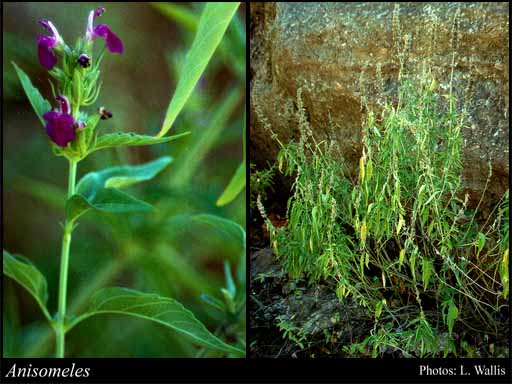- Reference
- Prodr.Fl.Nov.Holland. 503 (1810)
- Name Status
- Current

Scientific Description
Family Lamiaceae.
Habit and leaf form. Herbs; evergreen; bearing essential oils; not resinous. Plants unarmed. Perennial. Leaves cauline. Plants with neither basal nor terminal concentrations of leaves. Young stems tetragonal. Stem internodes solid, or hollow. To 0.8–2 m high. Self supporting, or climbing. Leaves small; opposite; not decussate; not decurrent on the stems; ‘herbaceous’; not imbricate; petiolate; aromatic, or foetid, or without marked odour; simple; epulvinate. Leaf blades entire; flat; narrowly elliptic, or triangular (to narrowly ovate); pinnately veined; cross-venulate; cordate to cuneate at the base, or rounded at the base. Mature leaf blades pilose, or woolly (sometimes). Leaves without stipules. Leaf blade margins crenate, or serrate; flat. Leaves without a persistent basal meristem. Leaf anatomy. Hairs present (hairs antrorse to subpatent); glandular hairs present; complex hairs absent. Branched hairs present. Urticating hairs absent. Stem anatomy. Secondary thickening developing from a conventional cambial ring.
Reproductive type, pollination. Fertile flowers hermaphrodite. Unisexual flowers absent. Plants hermaphrodite. Entomophilous, or ornithophilous; via hymenoptera, or via lepidoptera, or via diptera.
Inflorescence and flower features. Flowers aggregated in ‘inflorescences’. Inflorescence few-flowered to many-flowered. Flowers in cymes, in panicles, and in verticils. The terminal inflorescence unit cymose. Inflorescences axillary; thyrsoidal with the monchasial units of the inflorescence arranged in whorls. Flowers sessile; bracteate; small; very irregular; zygomorphic. The floral asymmetry involving the perianth and involving the androecium. Flowers cyclic; tetracyclic. Floral receptacle developing a gynophore, or with neither androphore nor gynophore. Free hypanthium absent. Hypogynous disk present, or absent. Perianth with distinct calyx and corolla; 4–10; 2 -whorled; isomerous, or anisomerous (or only dubiously interpretable). Calyx present; 5; 1 -whorled; gamosepalous; blunt-lobed, or toothed; prominently 10 veined; imbricate, or open in bud; exceeded by the corolla; tubular campanulate (conic basally, expanded distally); regular; non-fleshy; persistent; with the median member posterior. Calyx lobes triangular. Corolla present; disguisedly 5; 1 -whorled; gamopetalous; imbricate; bilabiate (the abaxial lip comprising the lateral and abaxial lobes, the abaxial lobe itself distally 2-lobed and much longer than the lateral lobes; the adaxial lobe erect); with contrasting markings; purple (to purple-mauve). Corolla members entire. Androecium present. Fertile stamens present. Androecial members definite in number. Androecium 4. Androecial members adnate; markedly unequal; free of one another; 1 -whorled. Androecium exclusively of fertile stamens. Stamens 4; becoming exserted; didynamous; all more or less similar in shape; reduced in number relative to the adjacent perianth; fertile stamens representing the posterior-lateral pair and the anterior-lateral pair; oppositisepalous; all alternating with the corolla members. Filaments hairy (puberulent or pubescent). Anthers connivent, or separate from one another; dorsifixed; versatile, or non-versatile; dehiscing via longitudinal slits; introrse; unilocular and bilocular (abaxial pair 2-celled, adaxial pair 1-celled); tetrasporangiate; unappendaged. Pollen shed as single grains. Fertile gynoecium present. Gynoecium 2 carpelled. The pistil 4 celled. Carpels reduced in number relative to the perianth. Gynoecium syncarpous; synstylovarious to eu-syncarpous; superior. Ovary plurilocular; 2 locular, or 4 locular. Locules secondarily divided by ‘false septa’. Gynoecium median; stylate. Styles 1; from a depression at the top of the ovary; ‘gynobasic’. Stigmas 2, or 1; 2 - lobed (unequally divided). Placentation basal. Ovules 2 per locule (per carpel), or 1 per locule (per locellus); ascending; apotropous; non-arillate; anatropous, or hemianatropous.
Fruit and seed features. Fruit non-fleshy; a schizocarp. Mericarps 4; comprising nutlets. Seeds non-endospermic; small. Embryo well differentiated. Cotyledons 2. Embryo straight.
Special features. The flowering nodes separated by extended internodes. About 3–6 flowers subtended by each floral leaf. Calyx limb 5 lobed. Corolla tube not exceeding the calyx. The upper lip of the corolla incorporating 2 members, the lower 3; (posterior, adaxial) lip of the corolla entire. Lower (abaxial) lip of the corolla 3 lobed.
Geography, cytology, number of species. Native of Australia. Not endemic to Australia. Australian states and territories: Western Australia, Northern Territory, and Queensland. Northern Botanical Province. A genus of 2 species, or 3 species; 1 species in Western Australia; 0 endemic to Western Australia.
Etymology. From the Greek for "unequal" and "limb"; the upper pair of anthers are single celled, while the lower pair are two celled.